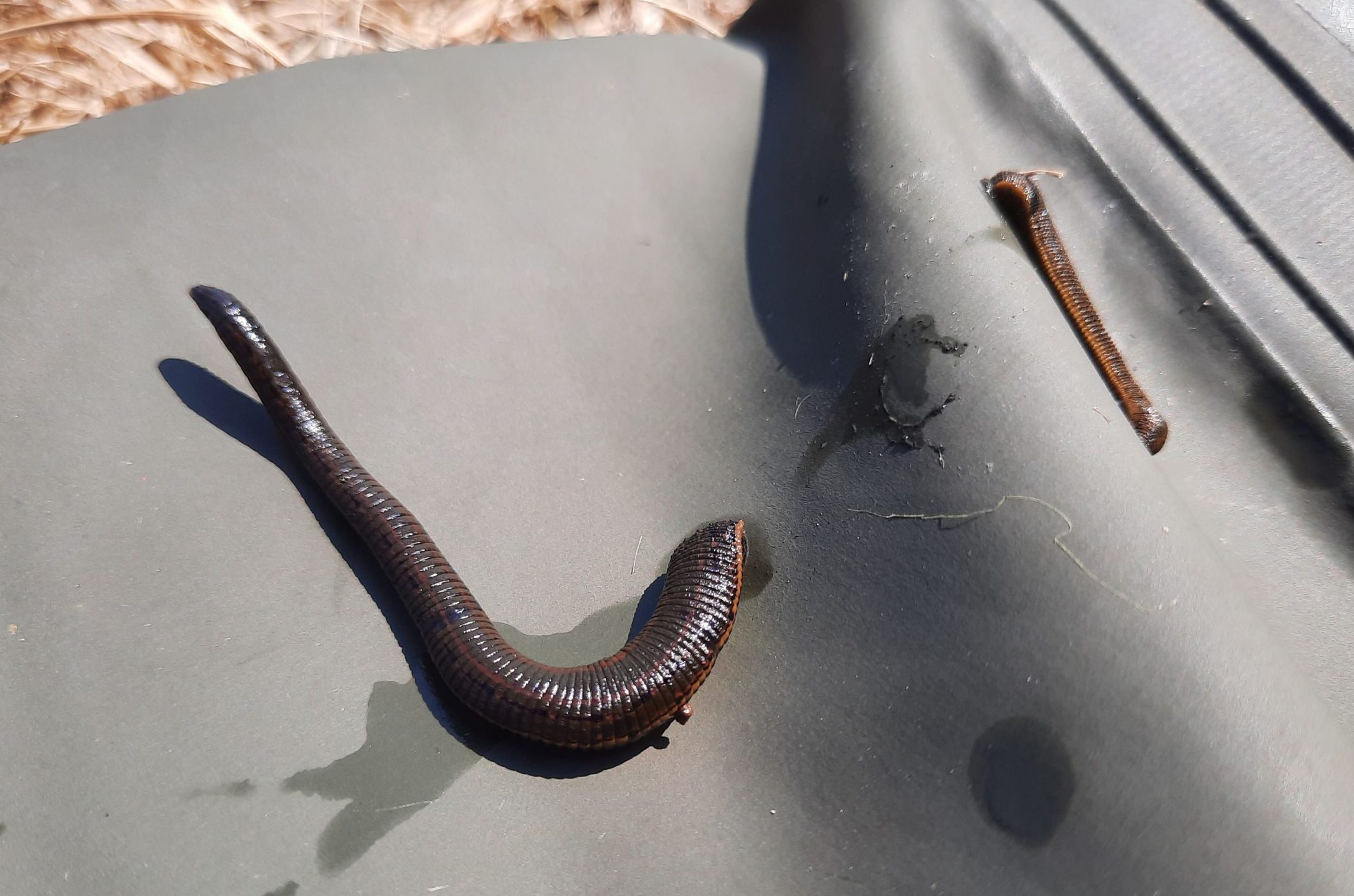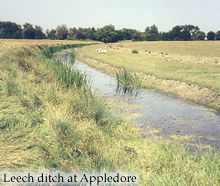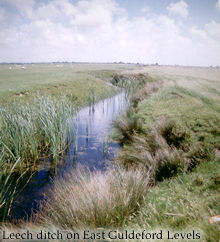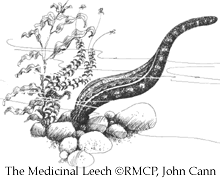Medicinal Leech
Most people are familiar with the historic use of blood sucking leeches in phlebotomy (bloodletting). It has frequently been a point of interest in modern day books, films and television shows. However, on the Romney Marsh, the story of the medicinal leech (Hirudo medicinalis) is one that continues into the present day.
The medicinal leech is the only British leech capable of sucking blood from humans and to fully understand its predicament we need to go back to William Wordsworth’s time at the beginning of the 19th century. The words of the leech gatherer in Wordsworth’s poem suggest that at this time they were already in decline and this trend was set to continue for at least another century.
Early declines in the species were almost certainly due to over-extraction from the wild, which hit its peak in the middle of the 19th century. Few people fully appreciate the scale of the trade in medicinal leeches at this time. In 1833 alone, approximately 42 million leeches were imported into France for medicinal use and around the same time 30 million were imported annually into America from Germany.
The European medicinal leech was reputedly preferred over its American counterpart (Hirudo decora) because it consumed larger amounts of blood. This highlights the enormous importance of leeches in medicine at the time, when there were few ailments for which they were not employed. The belief was that the medicinal leech had the ability to extract bad blood leaving good blood behind.
Leeches and the Romney Marsh
By the beginning of the 20th century, the medicinal leech had disappeared from most of its former range in Europe and was declared extinct in the British Isles. Since 1970, medicinal leech populations, have been found scattered across the British Isles, though not in Ireland where is it still thought to be extinct. In 1978 there was great excitement when a leech found attached to a dog that had been swimming in a disused gravel pit at Dungeness in Kent was identified as the medicinal leech (Hirudo medicinalis). Six years later a study carried out at the same gravel pit estimated the medicinal leech population there to be over 10,000 and the species was discovered in other pits in the Dungeness area.
It was not initially clear where these leeches had come from as all of the water bodies in which they had been found were a product of shingle extraction and hence, at that time, less than 50 years old. Leeches arriving from France whilst attached to birds was considered a possibility, as the animal can attach itself for more than an hour whilst feeding. In 1985 medicinal leech was recorded for the first time in a ditch running through grazing marsh inland from Dungeness on the Romney Marsh. It is likely that these populations had survived continuously throughout the period that they were thought to be extinct and are likely to be the stock that subsequently colonised the pits at Dungeness.
The Romney Marsh is an expanse of approximately 27,000 hectares of low-lying land in the South-eastern corner of England. Its most prominent feature is the great shingle promontory of Dungeness that juts out into the English Channel just along the coast to the South and West of Dover.
From 1998 to 2000, with funding from GlaxoSmithKline, Natural England and in partnership with the Royal Society for the Protection of Birds, a survey was carried out by the Romney Marsh Countryside Partnership to determine the distribution, diet and breeding requirements of the medicinal leech in the Romney Marsh area. The species was found at 85 locations across the Romney Marsh, predominantly in ditches on grazing marsh and in gravel pits and ponds at Dungeness. This is the largest known population in Britain and is of international importance.
Habitat
The species requires relatively high temperatures, particularly for breeding and is typically found in shallow water with plenty of submerged and marginal vegetation, where above average water temperatures are maintained in the spring and summer. It also requires a succession of vertebrate hosts throughout this period. Although over- collection of the species in the nineteenth century has been blamed for its decline, it is likely that habitat loss brought about by changes in land use, draining of marshland and increased management of aquatic vegetation and water levels has also contributed.
“He with a smile did then his words repeat
And said that gathering leeches far and wide,
He travelled, stirring thus about his feet
The waters of the pools where they abide
Once I could meet with them on everyside
But they have dwindled long by slow decay,
Yet still I persevere and find them where I may.”
From Resolution and Independence
by William Wordsworth, 1802

Two medicinal leeches, found by RMCP staff during a water vole survey in Dengemarsh Sewer
Surveying
The RMCP continues to monitor six medicinal leech sites on the Romney Marsh. Surveying involves standing in the water and splashing for a minimum of 20 minutes as this disturbance of the water attracts hungry leeches in search of a blood meal. In clear water, the animals can be seen quite clearly as they swim towards the point of splashing and can be easily netted. In murky ditches they arrive unseen and attach with their suckers to the surveyor’s wellington boots from which they must be carefully removed before they slide off.
Every leech that is caught is measured and ‘rolled’ gently between the palms of the hands in the hope that it will regurgitate some of its last blood meal onto a glass microscope slide. Only about 10% of leeches oblige, but from the analysis of these blood slides it has been possible to determine the type of hosts used by leeches in different habitats on the Romney Marsh. Results from our work show amphibians to be the most important hosts of leeches living in former gravel pits at Dungeness, whereas fish and birds are more important hosts in grazing marsh ditches. In contrast none of our samples contained mammalian blood.
Although medicinal leeches have been successfully bred in laboratories for some time, we know little about their requirements for breeding, particularly for egg- laying, in the wild. The medicinal leech leaves the water to lay its eggs, which are coated in a spongy protective cocoon. Cocoons must be deposited in a place where they will not dry out nor become waterlogged, and from where the young can easily reach the water after hatching. After a great deal of time spent foraging along banks, two medicinal leech cocoons were found attached to the roots of willowherb (Epilobium sp.) growing in shingle at Dungeness and two attached to grass roots on the bank of a grazing marsh ditch. One was also found in a disused moorhen’s nest, along with several well fed mature leeches.

Leech therapy
The final twist is that whilst the medicinal leech is a threatened and protected species in its natural habitat, it has made a comeback in medicine in recent decades and is being mass-reared for this purpose.
Bloodletting has become a proven medical technique particularly valuable in plastic and reconstructive surgery. Leech therapy is now being used to restore circulation to grafted tissues and reattached appendages. As many as 50 leeches may be used in succession on one patient post operatively. As they feed, they apply the perfect amount of suction to restore blood flow after delicate reattachment surgery. In half an hour, a leech will take about five times its own weight in blood, amounting to between 5 and 10 cm3.
Medicinal leech saliva also contains many useful medical compounds that have anaesthetic, vasodilator, anticoagulant and clot-dissolving properties.
These are some of the very real benefits to people that demonstrate the necessity of maintaining the biological diversity of our environment and the requirement for conservation. It is to be hoped that the resurgence in the use of the medicinal leech in medicine will help to ensure its protection in the wild. We still have a lot to learn about the ecology of this fascinating bloodsucker.

Summary of the Survey Results
During 1998 and 1999 the RMCP surveyed 153 waterbodies on the Romney Marsh for medicinal leech with funding from Natural England and GlaxoSmithkline.
The species was subsequently found in 53 ditches, the majority of which are on grazing marsh, and also in 28 former gravel pits around Dungeness. The Romney Marsh medicinal leech population is the largest in the British Isles and thus of international importance.
In 2000, monthly population monitoring was carried out at 10 sites on the Marsh. A total of 430 leeches were caught and measured in order to identify breeding sites and seasonal activity. Leeches were also ‘rolled’ to obtain bloodmeal samples. Analysis of these showed amphibians to be the most frequent hosts at former gravel pit sites, whilst birds and fish appeared to be more important hosts on grazing marsh.
Medicinal leech egg cocoons were found in 2000 for the first time on grazing marsh, having previously been found only at one gravel pit site at Dungeness.


